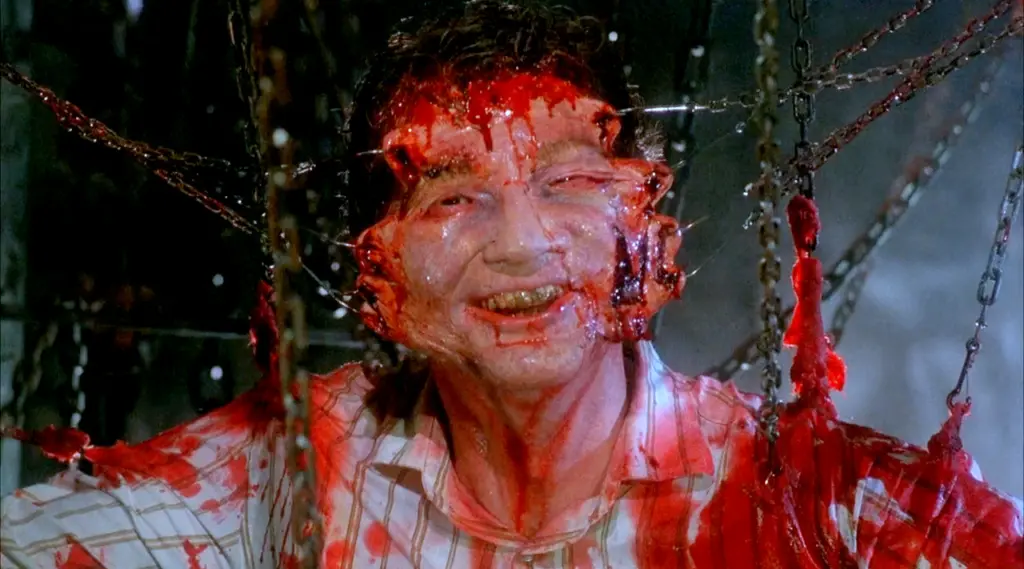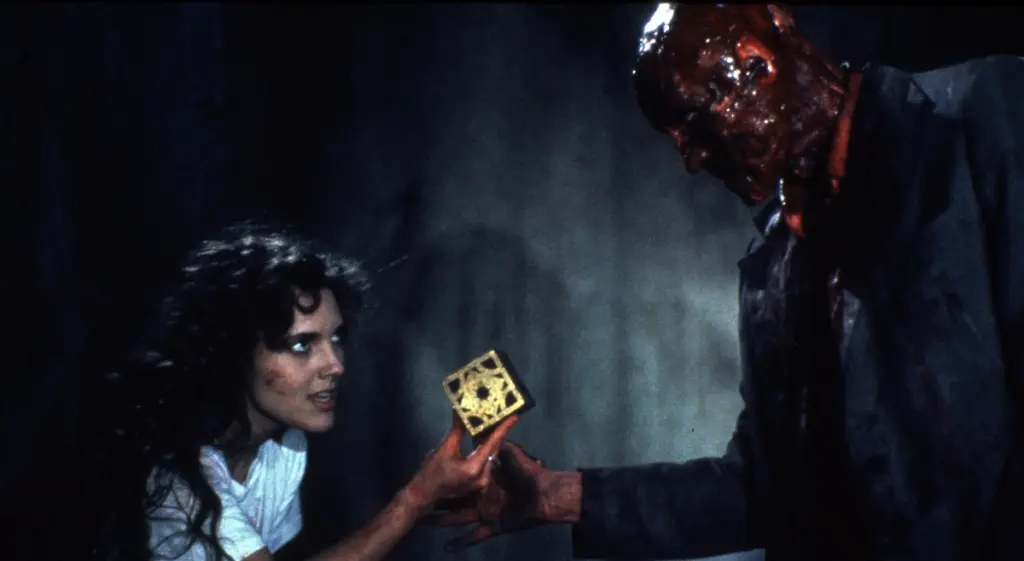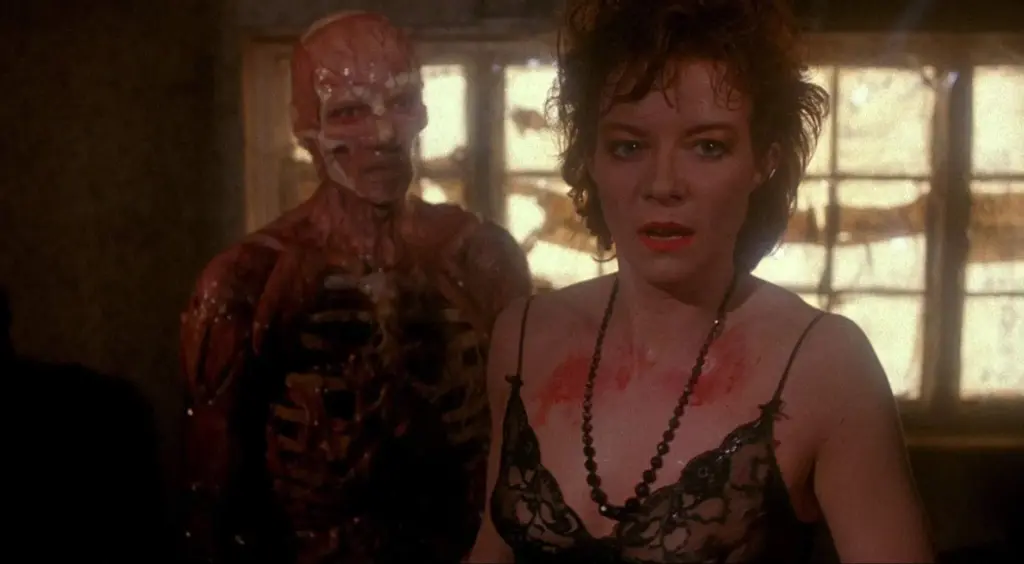
The Hellraiser episode of WTF Happened to This Horror Movie? was Written by Emilie Black, Narrated by Jason Hewlett, Edited by Lance Vlcek, Produced by Lance Vlcek and John Fallon, and Executive Produced by Berge Garabedian.
Clive Barker is someone horror fans know and love, someone that can easily be referred to as a Master of Horror. To some, he is more than that. The man has created entire universes of characters in his writing, deep with lore and some truly disturbing elements. Early on, his work became the source of film adaptations, but let’s be honest, they weren’t all exactly successful in bringing his words to the screen. Rawhead Rex was a bit of a mess; Underworld has issues, so why should he trust his Hellbound Heart to anyone else to direct?
And this is basically how Hellraiser (watch it HERE) was born. Kinda. There is, of course, so much more to it. Barker’s book, The Hellbound Heart, was first published in 1986, the same year that the film adaptation of Rawhead Rex was released, a time when Barker’s work was becoming more and more popular, and film adaptations were a go-to thing. The first two features made from Barker’s work were not exactly great, they are exciting and somewhat entertaining, but something is missing in both of these.
So, logically, making more of his work into films was needed. Still, he obviously had reservations about this, and to keep this one closer to his vision, it was decided that he would write and direct the cinematic adaptation of the novella. Barker took his book, adapted it to a script, made some needed changes, and got the green light to produce it. Considering his inexperience in the field of directing, getting approved to direct it and getting a budget of $900,000 was an excellent start. Of course, changes needed to be made to the story to be able to bring it to the big screen, as is usually the case with any book, but particularly with Barker’s books, as he has a particular style and imagination that most film producers, distributors, and theaters would not know what to do with.
So, Barker made some changes. The part of Rory became Larry, and Kirsty went from being a family friend to being Larry’s daughter and thus Frank’s niece adding an incestuous angle to things; the Cenobites have a bit of variation and a few more character changes. Also, what changed after producers came on board was the location from England to the US to have a broader appeal internationally. Another major change was that Pinhead was not necessarily the lead Cenobite in the book; he got less time than the others and only became the forefront Cenobite following the films and in The Scarlet Gospels book. One of the reasons for Pinhead, or the Priest, to come forth as the leader what that he was able to speak, while Butterball and Chatterer had limited speech, vision, and movement due to their masks and effects. In comparison, the Priest had easier movement and speech, with limited vision due to sclera contacts.
Also, the part of the Priest had gone to Doug Bradley, and, well, the man has screen presence in spades. Another change to the character of Pinhead from the novella is that the character is not clearly male in the story, the descriptors used are partially feminine, and some of the languages around that being are not entirely clear as to whether they are male or female, something not exactly surprising to any reader of Barker’s work. The part in the film went to Doug Bradley, and between his presence and performance, Pinhead became what he is, a brooding, effortlessly menacing, creepy yet attractive presence who has minimal screen time in this film, everything considered.
His performance basically made the character become more than expected, and with his return in the sequels, Pinhead became an icon of horror. Of course, the producers had some thoughts on him and how he should be. Given that slashers were huge in the 1980s, there was a push to make Pinhead a mix of Michael Myers, Jason Voorhees, and Freddy Krueger, meaning they wanted him to be more brooding, a silent killer, if you will, while also having him crack jokes and have more lines. Um, no. Thanks to Barker, this didn’t happen, and the Priest remained intelligent and scary.
And this brings us to casting. Originally, Doug Bradley was interested in playing one of the furniture movers, one of the men present when Larry cuts his hand on a nail that sticks out. He has said in interviews that he thought it would be a better move as a starting actor to have his face visible, that it would help his recognition and, thus, career. He did end up taking the part of the Cenobite, though, and has no regrets. As fans of horror know, that part is now so iconic, and his performance is why that is the case. He made Pinhead; he gave him life; he gave him the little something extra that made him more than just another killer, more than a mindless drone in a sea of them. Another important part is the one that went to Ashley Laurence, the part of Kirsty Cotton, Larry’s daughter, Julia’s stepdaughter, and Frank’s niece.

She is central to the story, and she needs to have that perfect mix of energies that would put her somewhere between innocent and not actually helpless. Kirsty is the final girl, but she’s also a character that mixes with everyone else in a way that feels both right and wrong, something the film relies on to create its mood and some of its “something is wrong here” feeling. Other actresses were considered, of course, and Ashley Laurence was most definitely the right choice. Jennifer Tilly was another actress who was considered, and let’s just face it now, the whole film would have felt very different had Kirsty been played by Tilly, who is beloved and for good reason, but probably not right for the part here.
Another important casting choice is Andrew Robinson, who plays Larry, Kirsty’s father, and also plays (spoiler warning), Frank using Larry’s face to live. Given that the two were brothers, it makes sense that they would carry themselves similarly, has similar bodies, and have similar ways, but also, the part becomes more complex with the switch as they have most definitely different personalities and different wants out of life. Robinson sells this beautifully well. Then we have Julia, the lady who married one brother while lusting over the other. Her part went to Clare Higgins, a self-admitted non-fan of horror who couldn’t watch more than 10 minutes of the film the first time she saw it.
From here, we have the casting choice, or rather choices, for Frank, who was almost played by Lance Henriksen, who passed and came back to the series with Hellworld; you know the one co-starring Henry Cavill? As it is, Frank was a more complex casting situation than other characters. You see, Frank has his human body and his undead body. There is the version of Frank that oozes sleaze; this version is the one that buys the Lament Configuration box and is the one that appeals to Julia’s carnal side. This part is played by Sean Chapman. Then there’s the undead Frank, more than gaunt, the man with no fat but also no skin, who is slowly coming back to life. This version of Frank is played by Oliver Smith, who gave the very visceral performance fans adore. Also, a part of Frank’s character and performance is the special effects.
Parts of the scenes for Frank are when he gets torn to shreds and when he gets brought back to life. These parts are all special effects, even having animatronics involved at times. This leads us into… The special effects this film would not have worked without these special effects. The team doing the special effects had quite the task in front of them once they got their assignments for the film. The whole revival of Frank was originally skipped thinking they would need more money to produce it. The original story even has him coming out more of the walls than just the floor, as his demise had sent parts everywhere.

It was also a lot more dusty than gooey. Once the film was done with the skip of the rebirth sequence, the studio was shown an edit of what they had so far, and they gave extra budget so that they could shoot the missing segments. This led to the effects team led by Bob Keen, creating effects that were then shot in reverse, like the sequence with the blood going into the floorboards being done by pushing gooey blood out through holes in the boards, the body coming back to life. This led to them creating things that are impressive to this day.
The work became something else on screen, and once paired with the work on the Cenobites by not just the effects team but also a wardrobe, and production design, the idea of these demons, as Barker sometimes refers to them. There is so much here that the special effects had to be on point. Some will say here, “But what about those bad computer effects near the end of the film?” Well, those were due to running out of funds, and Barker and a Greek, as he put it, got together, drank way too much, and did those effects over a weekend. So yea, they look rushed, cheap, and didn’t age well, and Barker doesn’t kid himself over them.
Another factor that changed a bit of the film, or a lot, was the MPAA, who are notorious for not liking certain things like sexual content, anything unusual, and violence that isn’t war-related. So here, the MPAA requested cuts, of course, so a few changes happened, and considering the content left, and that it was Barker, they probably didn’t know what hit them. One of those cuts was the hammer killing of the gentleman caller brought home by Julia had to be cut down.
Another cut had to do with spankings between Julia and Frank; changes were made to adult sequences, with Barker joking about it in interviews, saying that Frank was allowed two thrusts, but not three or it would be considered obscene. So, the MPAA, MPAA’d.
Did these changes to the story, all that budget going to the special effects, MPAA cuts, and cast selections, pay off? Let’s look at the numbers. The budget started at $900,000; then, it got upped to $1,000,000 by the producers after seeing the initial cut of the film. The film was released in theaters on September 18, 1987, with an R in the US. No dreaded NC-17 in the US meant a theatrical run was possible, so it got one. At the box office, the film made $14.6 million USD. Not back, close to 15 times its budget. This was considered a hit and led to one sequel, then another, then another; then eventually, the series became known as the series that used slush pile scripts often, meaning scripts that were okay but not connecting right, so they got Cenobites added in them and became Hellraiser franchise fodder.
This led to 9 sequels and one re-quel, as in a film that is both a remake and sequel. Of course, these all come back to the success of the original, a film that came out in theaters in the 1980s, when slashers were in full swing, and on a weekend where the top 10 box office contenders were Fatal Attraction, The Principal, The Pick-Up Artist, Hellraiser, Stakeout, Dirty Dancing, No Way Out, La Bamba, The Big Easy, and Can’t Buy Me Love, in order.
This meant that competition was fierce, yet the film did so well on a much smaller budget than many of the others listed. Also, just out of the top ten were Robocop, Predator, and Apocalypse Now. The 1980s were filled with hit films, so having a $1 million film, a fairly gruesome horror film, one without a huge star topping the poster, was kind of a miracle.
At this point, the film has been released on VHS, on DVD, on Blu Ray, multiple times each, in multiple regions and versions. There have been further cuts to the film in other countries and territories to avoid being banned or getting called immoral, the usual for the 1980s really. Now, the film is out in collector’s versions on Blu and has had plenty of different ways of being seen.
Of course, some of the cut footage is flat-out missing at this point, so getting a truly uncut version of the film is probably not going to happen anytime soon. Unless! Unless someone has it all at home or at work, like the missing footage from Nightbreed that was brought back a few years ago and allowed for a whole new vision and version of the film being released to the public by Seraphim and Clive Barker. So, whoever you are, if you find odd footage of Hellraiser, let it be known, as fans want those missing seconds of missing gore, the extra little bits that were a part of Barker’s original vision for the film.
A couple of the previous episodes of WTF Happened to This Horror Movie? can be seen below. To see more, head over to our JoBlo Horror Originals YouTube channel – and subscribe while you’re there!
Originally published at https://www.joblo.com/hellraiser-1987-wtf-happened/


